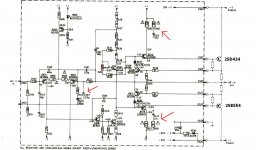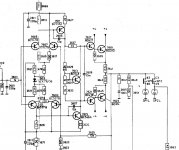ΟΚ ...here is a joke
the schematic attached is the main section amplifier of the philips 22AH708... its an amplifier rated 80Wpc at 8R 52+52 rails and seems to me a japanese design implemented by the european .... so its bootstrap... BC5XX all over but VAS DRIVERS and OUTPUTS are B668-9 2SB 2SD family .... funny i think ...
havent finished repairing it since a f**** open trimmer blown pretty much everything arround the VBE area so i have no listening impressions but there is a thing that got my eye arround the driver area there is a network like a zobel or filter next to the driver supply formed by 10R +47nf film capacitor ...
any comments ????
the schematic attached is the main section amplifier of the philips 22AH708... its an amplifier rated 80Wpc at 8R 52+52 rails and seems to me a japanese design implemented by the european .... so its bootstrap... BC5XX all over but VAS DRIVERS and OUTPUTS are B668-9 2SB 2SD family .... funny i think ...
havent finished repairing it since a f**** open trimmer blown pretty much everything arround the VBE area so i have no listening impressions but there is a thing that got my eye arround the driver area there is a network like a zobel or filter next to the driver supply formed by 10R +47nf film capacitor ...
any comments ????
Attachments
Sakis most amps have such networks, sometimes only a cap is used, duncanV explains it well. I think what looks more strange to you might be the 15 ohm resistors instead, now that you dont see much. Those help to maintain stability of the output section although I dont see why they would be required in a EF, in a triple outputstage those resistors help quite a bit.
corect so far ...seen capacitors here and there seen similar topology in hafler amplifiers
but the philips is a bit more than that and need to see it to understand ...it features piggy boards with ltp vas drivers and vi limiter placed in sort of a mother board to accomodate the output section only ...
There is no other bypass or decoupling elsewhere .... so this network located on the piggy boards next and close to the drivers does all the job
kind regards
but the philips is a bit more than that and need to see it to understand ...it features piggy boards with ltp vas drivers and vi limiter placed in sort of a mother board to accomodate the output section only ...
There is no other bypass or decoupling elsewhere .... so this network located on the piggy boards next and close to the drivers does all the job
kind regards
Philips's use of Japanese transistors was not that uncommon those days. Also Motorola's MJ's can be found in their 70's and 80's amplifiers. Just have a look at some MFB systems for example.
The 15R tackles the potential risk of resonance, caused by the PSU wire inductance.
The 15R tackles the potential risk of resonance, caused by the PSU wire inductance.
- Status
- This old topic is closed. If you want to reopen this topic, contact a moderator using the "Report Post" button.
- Home
- Amplifiers
- Solid State
- THE PHILIPS 22AH708

